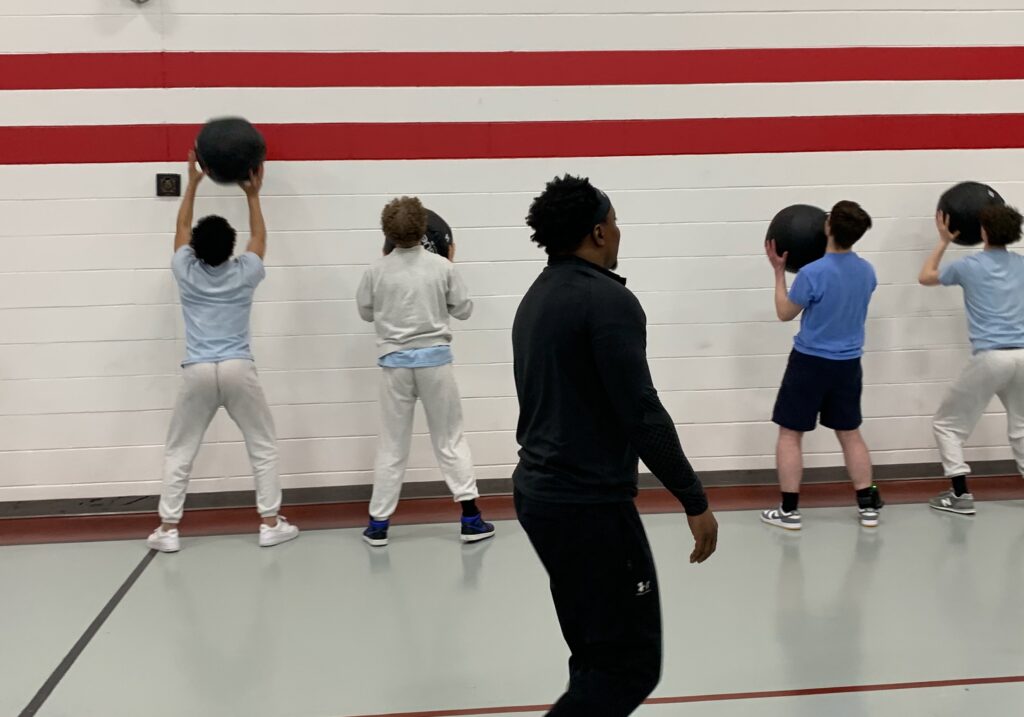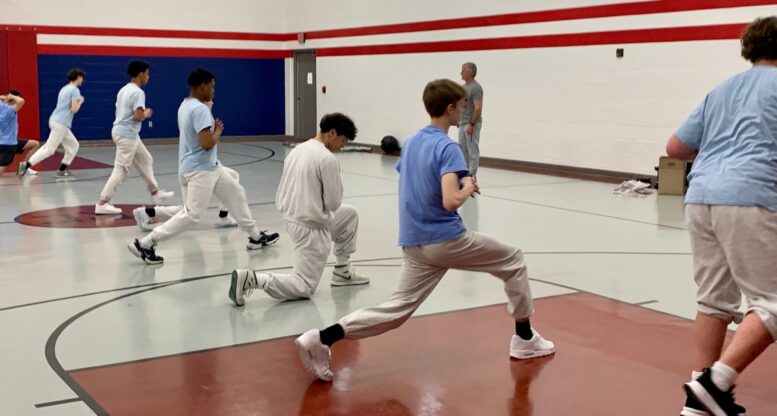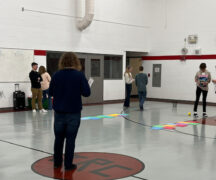By JULIECARLE
BG Independent News
Three afternoons a week, the gymnasium at the Juvenile Residential Center of Northwest Ohio, which is usually home to basketball, volleyball and kickball games, turns into a CrossFit fitness center.
About a dozen teens near their release times from the community correctional facility are sweating through rigorous workouts of wall climbs, pushups, and lunges, often on their way to physical fitness, mental toughness and success. They are part of a pilot project that is funded by the Ohio Department of Youth Services and facilitated by Expanding Horizons and coaches from Perrysburg’s CrossFit Fenix.
The program is designed to use the structure, discipline and community-building aspects of a CrossFit exercise regimen to inspire positive change, foster accountability and reduce the chance of re-offenses of juvenile offenders.
They learn the routine and benefits of exercise and the CrossFit community inside JRC. After they are released from the center, they are connected to a local CrossFit gym to reap the benefits of a continued exercise routine in a new, yet familiar, welcoming fitness community.
Where it began in Ohio
The Juvenile Residential Center of Northwest Ohio was selected as the first of the 11 community correctional facilities in the state to pilot the CrossFit program; however, in Ohio, the beginnings of the fitness program being used for rehabilitation of juvenile offenders goes back about seven years.
CrossFit Crave in Celina was asked to facilitate a program with their local probation department, according to Matt Shindeldecker and Debbie Wagner, co-owners of the Celina CrossFit gym that started the program.
They started small but grew exponentially. Eventually, their low recidivism rates captured the attention of Gov. Mike DeWine and the Ohio Department of Youth Services.
Expanding Horizons, an offshoot of the Celina business, was established to focus solely on developing similar CrossFit programs in long-term juvenile correctional facilities in Ohio and beyond.
The program takes the foundation of CrossFit’s exercise and fitness training and adds a requirement for all coaches to go through trauma-informed training, “which is so applicable for all of our kids,” said Wagner, who is responsible for connecting CrossFit coaches with the facilities and also identifying gyms that will welcome the youths once they are back in their communities.
When a resident is about a month away from dismissal, Wagner and her team work to find a CrossFit near. “We talk to the owners, get the coaches trauma-informed, work through any transportation issues to make sure he goes twice a week,” she said. “The state will pay for the first three months while he gets on his feet.”
“Barbell and body weight movement result in fitness, but the foundation of CrossFit is community,” said Shindeldecker. “It is really about the camaraderie that happens inside of a coach-led class.”
The youths are working out together on the same routine, but they are working at their own pace. “At the end of it all, they can high-five the individual next to them and say, ‘Hey, you did a great job today,’” he said.
Feb. 3, 2025–Day One at JRC
CrossFit Fenix in Perrysburg, which opened in November 2023, was the gym identified to help with the Bowling Green facility. The official start date was Feb. 3, 2025.
“We loved the idea of getting involved. We weren’t sure how it was going to go, but when we came in, they were ready to go,” said Steffon Thomas, one of the Fenix coaches who trains the youths in the program.
“The first few days, they were huffing and puffing and by week three they were asking us to do longer workouts,” Thomas said. “We’ve seen incredible progress, even after the first day.”
He believes programs like CrossFit are important for young men who are searching for ways to fill their time and to find a purpose.
“Having something like CrossFit is a powerful tool for helping them to focus their energy and learn new skills and ways to cope,” he said. “I love youth sports, but there’s only a limited number of people who can be on a team. In CrossFit, everybody can come. It doesn’t matter if you can make a basket or run a touchdown. Everybody can get in and find something they are good at.”
The physical effects are obvious, such as improved cardiovascular endurance, Thomas said. However, the CrossFit coaches and JRC staff are seeing additional benefits such as confidence, camaraderie, resilience and discipline.
JRC Executive Director Montana Crawford agrees. “At JRC, our program focuses a lot on self-control skills, but one thing they sometimes struggle with toward the end is that mindset of ‘I’ve got this; I can do this,” he said. “This is giving them the idea that they have to push through the workout and keep going even if they are exhausted and ready to be done.”
At the center, the teens often struggle with competition, trying to prove they are the biggest or the strongest.
“With CrossFit, that is kind of stripped away. When one or two guys aren’t done, the next guy comes over, encourages them and jumps down with them to push them in a healthy way,” he said. “They work together, are part of a team and do the work together.”
Going through the program is like learning a foreign language, explained Wagner, who is also co-founder with Shindeldecker of Expanding Horizons and the main person working to connect programs like the Bowling Green facility to local CrossFit businesses.
“One of the things we love is being able to bring life into this for them,” she said. “We talk about resilience and how to do the hard stuff.”
For example, there might be a time when they want to give up, but because they are working with a partner, they’ve learned that they don’t want to let the partner down.
The lessons stay with them while they are in treatment and after they are out, Wagner said. “You might want to give up, whether you’ve had an argument with someone or are discouraged for whatever reason. We talk about who can you reach out to and who’s depending on you.”
And when they are done with a workout, there is a psychological phenomenon when they are trying to catch their breath where conversations are different. “There is that bonding in this 10-15 minutes where conversations are different, and it’s received a hundred times better,” Wagner said.

The change in attitude has been noticeable as well, Crawford said. The participants who are selected based on good behavior and pending release, look forward to the workouts and the lessons as they are building rapport with one another and with the coaches, an extra adult support that isn’t JRC staff, their family or probation officers.
“They don’t view this as ‘I deserve this’ but instead, ‘I want to be a part of it. I want to earn my way in,” he said.
These young men, who represent about a quarter of the teens at JRC, also become role models for the other residents. “They love coming in here with the workout and the vibe of what’s happening. All the kids are watching, listening and seeing the positive feedback and the coach interactions, and they want to be a part of it,” Crawford said.
Beyond the center
In the nearly two months since the program started at the residential center, there have already been three residents who have been released and welcomed into nearby CrossFit communities, Crawford said. Two have memberships paid for by their local Family and Child First Council and one membership will be covered by the Ohio Department of Youth Services.
“It’s very exciting that we are seeing the linkage to the community already happening,” he said.
Aiden, one of the residents who recently transitioned from the center to his home community, said the CrossFit program was a learning experience. “It’s definitely about relationship building,” that he learned at JRC, but was also allowed to try at CrossFit gym near his hometown on weekends before his official release.
In addition to improved physical fitness and endurance, Aiden said, “I haven’t felt this well in a really long time; I can definitely see and feel the difference.”
He appreciates the support and push of the CrossFit environment.
“It builds confidence in other people and builds confidence within yourself,” he said. “I tell my mom all the time, I just love going there, even waking up early to go work out. Afterwards, I have such a feeling of satisfaction within myself; I feel amazing.”
Once the teens are in their own communities, they will be monitored to gauge their attendance for a period of time.
“It’s great if they go once or twice, but we want it to be regular attendance, so they have that support,” Crawford said. “If the kids are going out, participating and being successful, and that support from the state continues, it will dictate if we go from a pilot project to being part of the program. It could grow very quickly.”
Currently, the center has an 83% success rate of former residents staying out of trouble for three years past their release. “Will we save every kid? No, but we continue to look at what else we can do. This is one of those pieces that gives more positive adult support, more structure, more physical and mental health support.,” he said. “With this program, we are hoping to trim that 17% who still struggle a little bit when they leave down to 10%.”
Crawford credited Laura Fullenkamp and the Wood County Alcohol, Drug Addiction and Mental Health Services (ADAMHS), where she is director of planning and evaluation, for introducing the CrossFit program before the Department of Youth Services’ involvement.
“We have really focused on things we can do to go beyond the standard treatment protocols. We are meeting these kids where they are with what they need to successfully complete the program,” he said.
“The Wood County ADAMHS board has seen the value of what we are doing here and has been so supportive of this program and others. So we are going to keep doing it.”
“Incorporating programs like CrossFit into our juvenile residential center enhances positive behavioral health by teaching resilience, goal-setting, and self-regulation,” Fullenkamp said. “Unique initiatives like these equip youth with valuable life skills that promote long-term success and well-being. The Wood County ADAMHS Board applauds our local JRC for their creativity and dedication to providing holistic care for our youth!”
“This groundbreaking CrossFit program embodies the power of partnership,” said Ohio Department of Youth Services Director Amy Ast. “By uniting the expertise of certified CrossFit coaches, a trauma-informed approach, dedicated facility staff, and engaged community partners, we are providing young people with a unique opportunity for growth, habilitation, and the development of essential life skills – setting them up for success.”





